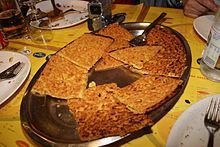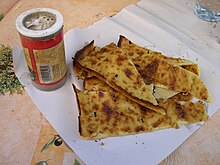Farinata
This articleneeds additional citations forverification.(March 2013) |
 | |
| Alternative names | Farinata di ceci,torta di ceci,fainé,fainá,cecìna,socca |
|---|---|
| Type | Pancake |
| Region or state | Liguria;Provence |
| Main ingredients | Chickpea flour,water,olive oil |
Farinata(Italian:[fariˈnaːta]),socca(French:[ˈsɔkka]),farinata di ceci,torta di ceci,fainé,fainá,cecìnaorcadeis a type of thin, unleavenedpancakeorcrêpemade fromchickpea flour.
Farinatais a typical preparation of the northwest Mediterranean coast; inLiguriait is namedfarinata,inNicesoccaand inTouloncade.
It is also a speciality ofOran,Algeria, where it was introduced underFrench ruleand known ascalentica,and in the cities ofBuenos Aires,Argentina, andMontevideo,Uruguay, where it is known asfaináand eaten withpizza.
History
[edit]The origin of the dish is unknown. One legend says it was invented by a group of Roman soldiers who roasted chickpea-flour on a shield.[1]
Names
[edit]In standard Italian, the dish is calledfarinata('made of flour'), while inLigurian,specifically in theGenoese dialect,it goes by the name offainâ(Ligurian:[fajˈnaː]); in Massa and in Carrara it is calledcalda calda(lit. 'hot hot'), inTuscanycecina( "made of chickpeas" ) ortorta di ceci(lit. 'chickpea pie'), and inSardiniafainé.
In Nice and theAlpes-Maritimesit is calledsocca,and in theVar,especially in Toulon, it is known ascade,fromOccitanpascade,as it was traditionnaly served during Easter (Pascasin Occitan).[2]
InArgentinaandUruguayit is massively popular and is calledfainá.
Cooking method
[edit]Farinatais made by stirringchickpea flourinto a mixture of water andolive oilto form a loosebatter,[3]pouring it into a pan to make a pancake typically 4 mm thick, and cooking it for a few minutes, traditionally in an open oven in a tin-plated copper baking-pan. It may be seasoned with freshrosemary,pepperandsea salt.Traditionallyfarinatais cut into irregularly shaped triangular slices, and eaten (with no toppings) on small plates with optional black pepper. Elsewhere in Italy – traditionally in Tuscany, where it is calledcecina(from the Italian word for 'chickpea',ceci) – it is served stuffed into smallfocaccia(mainly inPisa) or between two slices of bread, as it is traditional inLivorno.It is sold in pizzerias and bakeries.
Italian variations
[edit]This section is empty.You can help byadding to it.(April 2024) |
French variations
[edit]


- Soccais also a specialty of southeastern French cuisine, particularly in and around the city ofNice,[4]and is practically the same as farinata, some say the texture is a bit different. It may be baked on a tinned copper plate more than a meter in diameter.
- AroundToulonandMarseille,it is also possible to find it under the namecade.This version is thicker with a crunchy surface.
- Panisseis a specialty of Marseille, and is a similar dish, but thicker, and is typically cut into circles and fried.
Elsewhere
[edit]InAlgeria,karantikais a similar dish which is very popular. It is served hot and dressed withcuminandharissa.[5]
InArgentinaandUruguay(where many thousands of Ligurian people emigrated between the 19th and the 20th centuries) farinata is known asfainá,similar to the originalGenoesenamefainâ.It is often eaten on top of pizza (a caballo).[6]
In Uruguay,el fainá(calledla faináin Argentina) is considered a traditional Uruguayan dish, brought by immigrants in 1915, so much so that 27 August has been called "Fainá Day".Faináis optionally servedde orilloordel medio,which means from the border and from the center, because slightly irregular baking is made from to themeniscusof the liquid dough, making it thicker at the center, resulting different textures, more creamy or more crispy akin to the choice.[7]
InGibraltar,it is known ascalentitawhen it is baked orpanissawhen it is fried. They are typically eaten plain, without any toppings. These are considered to be Gibraltar's national dishes.[8]
See also
[edit]References
[edit]- ^Rosie Whitehouse (2016).Liguria.Bradt Travel Guides. p. 35.ISBN9781784770105.RetrievedJuly 24,2018.
- ^Marmottans, Tony (2000).Toulon et son histoire du Moyen Age à la Belle Epoque(in French). Autres temps.ISBN978-2-84521-063-9.
- ^Yotam Ottolenghi(14 November 2014)."Sheer poetry: Yotam Ottolenghi's chickpea flour recipes, from farinata to chickpea pancakes".The Guardian.Retrieved4 February2016.
- ^"A Brief History of Socca, France's Chickpea Pancake".February 2017.
- ^La calentitaArchived2007-12-19 at theWayback Machine,afaulxbriole.free.fr.
- ^Booth, Amy."Buenos Aires' unusual pizza topping".www.bbc.com.Retrieved2022-05-10.
- ^"El Fainá cumple 93 Años en Uruguay. El 27 de agosto es el día del auténtico fainá - Montevideo Portal - www.montevideo.com.uy".Montevideo.com.Retrieved4 February2016.
- ^"Ligurian Chickpea Pancake Recipe (Farinata)".The Spruce.Archived fromthe originalon 2010-02-17.Retrieved2018-02-05.

